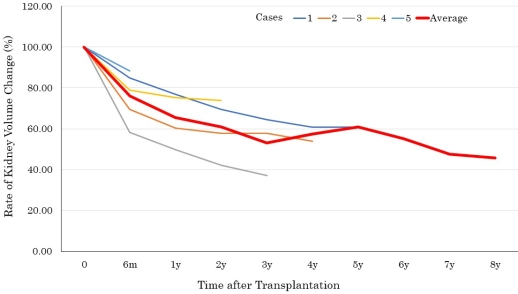Native Kidney Volume Decreases after Kidney Transplantation in Patients with Autosomal Dominant Polycystic Kidney Disease: Less Patients Need Nephrectomy?
1Nephrology, Hirosaki University, Hirosaki, Japan
2Urology, Hirosaki University, Hirosaki, Japan.
Meeting: 2018 American Transplant Congress
Abstract number: C154
Keywords: Kidney transplantation, Nephrectomy, Polycystic kidney disease
Session Information
Session Name: Poster Session C: Kidney Technical
Session Type: Poster Session
Date: Monday, June 4, 2018
Session Time: 6:00pm-7:00pm
 Presentation Time: 6:00pm-7:00pm
Presentation Time: 6:00pm-7:00pm
Location: Hall 4EF
Background.
The clinical implication of kidney volume decline on abdominal symptom improvement after kidney transplantation in patients with autosomal dominant polycystic kidney disease (ADPKD). We investigated the change of kidney volume and abdominal symptom in ADPKD patients who underwent kidney transplantation.
Patients and Methods.
Between June 2006 to November 2017, we perfumed 100 kidney transplantations in our hospital. Of those, we investigated kidney volume, abdominal symptom, and quality of life before-and-after kidney transplantation in five patients with ADPKD. The kidney volume was evaluated using computed tomography (CT) at the time of transplantation, 6 months and every year after transplantation up to 8 years. Abdominal symptoms including nausea, pain, fullness, and global quality of life were measured by visual analog scale.
Results.
The mean of total native kidney volume was 5,961 (range: 2,784 to 8,486) cm3 at the time of transplantation. Their kidney volumes were significantly reduced after transplantation, decreasing to 76.0%, 65.6% and 60.9% at 6 months, 1 and 2 years, respectively.  Two patients of 5 simultaneously received unilateral native nephrectomy at the transplantation due to the gastrointestinal symptom or to obtain the space for the kidney graft. Abdominal symptoms and global quality of life were significantly improved between before and after kidney transplantation regardless of unilateral native nephrectomy.
Two patients of 5 simultaneously received unilateral native nephrectomy at the transplantation due to the gastrointestinal symptom or to obtain the space for the kidney graft. Abdominal symptoms and global quality of life were significantly improved between before and after kidney transplantation regardless of unilateral native nephrectomy.
Conclusions.
The volume of native kidneys was significantly decreased after kidney transplantation in ADPKD patients. In addition, abdominal symptoms and global quality of life were significantly improved between before and after kidney transplantation regardless of unilateral native nephrectomy. These suggest that the indication for native nephrectomy might be limited to selected patients with complications such as infection or hemorrhage.
CITATION INFORMATION: Murakami R., Nagawa D., Nakata M., Narita I., Fujita T., Shimada M., Nakamura N., Tomita H., Hatakeyama S., Yoneyama T., Hashimoto Y., Koie T., Ohyama C. Native Kidney Volume Decreases after Kidney Transplantation in Patients with Autosomal Dominant Polycystic Kidney Disease: Less Patients Need Nephrectomy? Am J Transplant. 2017;17 (suppl 3).
To cite this abstract in AMA style:
Murakami R, Nagawa D, Nakata M, Narita I, Fujita T, Shimada M, Nakamura N, Tomita H, Hatakeyama S, Yoneyama T, Hashimoto Y, Koie T, Ohyama C. Native Kidney Volume Decreases after Kidney Transplantation in Patients with Autosomal Dominant Polycystic Kidney Disease: Less Patients Need Nephrectomy? [abstract]. https://atcmeetingabstracts.com/abstract/native-kidney-volume-decreases-after-kidney-transplantation-in-patients-with-autosomal-dominant-polycystic-kidney-disease-less-patients-need-nephrectomy/. Accessed December 28, 2025.« Back to 2018 American Transplant Congress
